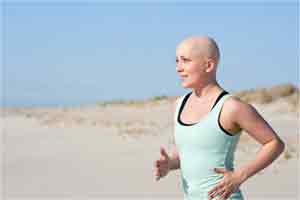Physical Activity Significantly Extends Lives of Cancer Survivors
 Physical activity significantly extends the lives of male cancer survivors, a new study of 1,021 men has found.
Physical activity significantly extends the lives of male cancer survivors, a new study of 1,021 men has found.
During the period while the men were followed, those who expended more than 12,600 kilojoules per week in physical activity were 48 percent less likely to die than those who burned fewer than 2,100 kilojoules per week.
Kathleen Y. Wolin, PhD, of Loyola University Chicago Stritch School of Medicine, is co-author of the study, published in the Journal of Physical Activity & Health, the official journal of the International Society for Physical Activity and Health.
Many cancer survivors are living longer, due to earlier diagnosis and better treatment, and their numbers are increasing rapidly. “Thus physical activity should be actively promoted to such individuals to enhance longevity,” researchers concluded.
There has been extensive research showing that among generally healthy, cancer-free populations, physical activity extends longevity. But there has been relatively little such research on physical activity among cancer survivors.
Researchers examined data from the Harvard Alumni Health Study, an ongoing study of men who entered Harvard as undergraduates between 1916 and 1950. Researchers looked at 1,021 men (average age 71) who previously had been diagnosed with cancer. In questionnaires conducted in 1988, men reported their physical activities, including walking, stair-climbing and participation in sports and recreational activities. Their physical activities were updated in 1993, and the men were followed until 2008.
Compared with men who expended fewer than 2,100 kilojoules per week in physical activity, men who expended more than 12,600 kilojoules per week were 48 percent less likely to die of any cause during the follow-up period. This finding was adjusted for age, smoking, body mass index, early parental mortality and dietary variables. (By comparison, a 176-pound man who walks briskly for 30 minutes a day, five days a week burns kilojoules.)
There were similar findings for mortality from cancer and cardiovascular disease: the most physically active cancer survivors were 38 percent less likely to die of cancer and 49 percent less likely to die of cardiovascular disease during the follow-up period.
Wolin is an epidemiologist. She is researching the role that exercise, obesity and other lifestyle-related factors play in the prevention of cancer and in improving outcomes after diagnosis. She also is studying how to improve outcomes once a disease is diagnosed. She earned her ScD from Harvard, and now is an associate professor in the departments of Public Health Sciences and Surgery at Loyola University Chicago Stritch School of Medicine. Wolin’s team is recruiting colon cancer survivors for a home-based strength-training intervention.
Source Newsroom: Loyola University Health System
Citations: Journal of Physical Activity & Health

